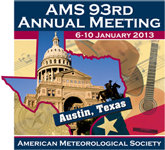 Scientists from around the world use the U.S. Department of Energy’s Atmospheric Radiation Measurement (ARM) Climate Research Facility to conduct their research, ranging from short-term field campaigns to long-term data analyses, weather and climate model comparisons, and measurement validation efforts. At the 93rd American Meteorological Society Annual Meeting, they share research results ranging from new classes of cloud and black carbon aerosols to highly complex data sets from scanning radars. The meeting takes place in Austin, Texas, from January 6-10, 2013.
Scientists from around the world use the U.S. Department of Energy’s Atmospheric Radiation Measurement (ARM) Climate Research Facility to conduct their research, ranging from short-term field campaigns to long-term data analyses, weather and climate model comparisons, and measurement validation efforts. At the 93rd American Meteorological Society Annual Meeting, they share research results ranging from new classes of cloud and black carbon aerosols to highly complex data sets from scanning radars. The meeting takes place in Austin, Texas, from January 6-10, 2013.
In keeping with this year’s meeting theme “Taking Predictions to the Next Level: Expanding Beyond Today’s Weather, Water, and Climate Forecasting and Projections,” below are a few topics of note. For a complete list, see the presentations page.
U.S. Department of Energy’s Wanda Ferrell Recognized for Leadership in Atmospheric Science
For sustained contributions to atmospheric sciences, Dr. Wanda Ferrell is receiving the prestigious “Cleveland Abbe Award for Distinguished Service to Atmospheric Sciences.” Ferrell, ARM Facility program manager, is receiving the award “for skillful, dedicated leadership in managing the Atmospheric Radiation Measurement Climate Research Facility, which has improved knowledge about the interactions among clouds, radiation, and aerosols.” By virtue of the award, Ferrell is also being inducted as a new AMS Fellow.
• Sunday, January 6, Exhibit Hall 3: 5:45-7:15 PM – New AMS Fellows Reception
• Wednesday, January 9, Exhibit Hall 4: 5:30-6:30 PM – Cleveland Abbe Award Reception.
Aerosol Impacts: Accelerating the Transition of Research Results into Operations
The 2007 Intergovernmental Panel on Climate Change assessment report highlights the scientific and societal importance for improved understanding on the aerosol–cloud-climate interactions to better assess the linkages between anthropogenic activities and climate. In the Fifth Symposium on Aerosol-Cloud-Climate Interactions, several presenters will show how ARM data are advancing the knowledge of aerosols to improve prediction skill at both weather and climate scales.
Tuesday, January 8, Room 5ABC
• 8:45 AM – Kinetics of CCN Activation and Droplet Growth Observed in Recent Field Campaigns, Fan Mei and J. Wang, discuss the growth of organic aerosols and their impact on cloud droplet formation.
• 11:15 AM – Aerosol Indirect Effects on Circulation and Radiative Forcing Through Deep Convection Clouds: Long-time Effects, Jiwen Fan, L. Y. R. Leung, D. Rosenfeld, Z. Li, and Q. Chen, discuss aerosol impacts on regional weather and climate shown by cloud simulations using long-term data from Oklahoma, China, and the tropics.
• 1:30 PM – Invited Presentation: Increasing Evidences of the Impact of Aerosols on Cloud, Precipitation, and Radiation due to Aerosol Indirect Effects, Zhanqing Li (invited) discusses the exponential increase in relevant studies, the discrepancy in published findings, and the observational data sets that cut through the clutter.

